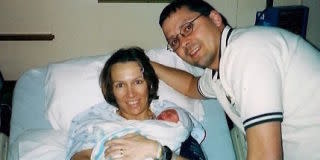I Regret Having an Epidural-Free Childbirth

As a long-time athlete, I’ve always prided myself on my high pain tolerance and ability to power through even the toughest situations. So when I got pregnant with my first baby, I knew immediately I wanted a natural childbirth. I trusted that all the strength and stamina I’d built up - I once finished a whole Ironman - would help me, and I was committed to keeping the experience drug-free for health of the baby. Plus, I’d heard that epidurals could slow down labor and increase the risk of a C-section - I definitely did not want a C-section.
To make sure I’d the all-natural delivery I wanted, I hired a midwife and signed up at a birthing center. Throughout my pregnancy, my husband and I also took classes in the Bradley Method, which stresses that childbirth is a natural process and that women can be taught to deliver without unnecessary medical interventions. It’s all about helping the woman be an active part in the delivery process - something they say is much harder to do if you’re drugged up - and focuses on using natural breathing and relaxation techniques, along with proper nutrition, exercise, and education.
All of this sounded beautiful and wonderful - until the day I actually went into labor.
It started out fine: My water broke on its own, no induction necessary, and we headed happily to the birthing center. But then we waited. And waited. And waited some more. The longer nothing happened, the more I started to worry. Nine hours and zero contractions later, my midwife decided it was time for a little medical help and started me on Pitocin, a drug that starts contractions.
All I remember is throwing up and hoping for an end to the awful pain.
And that’s where everything started to deviate from my carefully prepared birth plan. Because I was on Pitocin, I had to be under a doctor’s supervision, so I was moved to a nearby hospital. I reacted quickly to the drug, which was a good thing, except that it brought labor on fast and furious. Six hours later, I was pushing, and the pain was horrific. All I remember is throwing up and hoping for an end to the awful pain. Everything I had hoped for - the nice, calm environment, the controlled breathing, the meditative birth - flew out the window. All I could do was hope the baby would come soon.
And he did. My son Adam was born healthy and hearty.
I, on the other hand, was a mess. Even though the baby was out, the torture wasn’t over. The doctor had switched off the Pitocin after delivery and my contractions had stopped immediately, before the placenta could be delivered. Because the placenta wouldn’t detach, the doctor had to manually remove it. That means the doctor had to scrape the placenta off the wall of my uterus - the same uterus that had just birthed a baby - while I had no pain medication whatsoever.
By that point, I was so utterly exhausted, having lost a lot of blood, and in so much pain I had to wonder if going “drug-free” was really worth it. My baby was here, safe and sound, and that was the most important thing. But it made me realize there is so much more to delivery than the perfect birth scenario.
Three years later when I gave birth to my daughter, I got the epidural. There was no guilt or worry this time; I just didn’t want that excruciating pain again. And, ironically, thanks to the pain meds, her delivery ended up being the blissed-out birth I’d always dreamed of.
You Might Also Like
